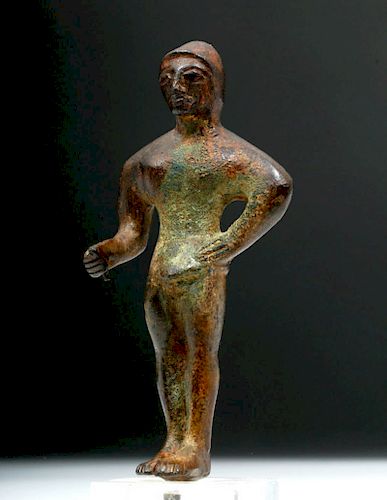Etruscan Bronze Statue of a Kouros
Lot 50a
About Seller
Artemis Fine Arts
686 S Taylor Ave, Ste 106
Louisville, CO 80027
United States
Selling antiquities, ancient and ethnographic art online since 1993, Artemis Gallery specializes in Classical Antiquities (Egyptian, Greek, Roman, Near Eastern), Asian, Pre-Columbian, African / Tribal / Oceanographic art. Our extensive inventory includes pottery, stone, metal, wood, glass and textil...Read more
Estimate:
$4,500 - $6,750
Absentee vs Live bid
Two ways to bid:
- Leave a max absentee bid and the platform will bid on your behalf up to your maximum bid during the live auction.
- Bid live during the auction and your bids will be submitted real-time to the auctioneer.
Bid Increments
| Price | Bid Increment |
|---|---|
| $0 | $25 |
| $300 | $50 |
| $1,000 | $100 |
| $2,000 | $250 |
| $5,000 | $500 |
| $10,000 | $1,000 |
| $20,000 | $2,500 |
| $50,000 | $5,000 |
| $100,000 | $10,000 |
| $200,000 | $20,000 |
About Auction
By Artemis Fine Arts
Jun 20, 2019
Set Reminder
2019-06-20 10:00:00
2019-06-20 10:00:00
America/New_York
Bidsquare
Bidsquare : Ancient / Ethnographic From Around the World
https://www.bidsquare.com/auctions/artemis-gallery/ancient-ethnographic-from-around-the-world-4217
Around the world & back in time - be amazed at the treasures you will find. Antiquities from Egypt, Greece, Italy and the Near East, Asian, Pre-Columbian, African / Tribal / Oceanic, Native American, Spanish Colonial, Russian Icons, Fine Art, much more! All categories, all price ranges.. all legal Artemis Fine Arts info@artemisgallery.com
Around the world & back in time - be amazed at the treasures you will find. Antiquities from Egypt, Greece, Italy and the Near East, Asian, Pre-Columbian, African / Tribal / Oceanic, Native American, Spanish Colonial, Russian Icons, Fine Art, much more! All categories, all price ranges.. all legal Artemis Fine Arts info@artemisgallery.com
- Lot Description
Italy, Etruria, Etruscan people, ca. 6th to early 5th century BCE. A cast bronze example of a form that originated in Archaic Greece, a kouros. This figure depicts a young man with his left foot forward and one hand raised. The figure is an homage to male youth, the highest ideal of beauty in the Classical world, and appears to be nude aside from a tight cap on the head; he has wide, staring eyes, small nose and mouth, and wears a small skirt that just barely hides his manhood. The figure probably once held an attribute in his raised hand, which is closed, suggesting that it was cylindrical in shape. The figure is cast to have a long spike that juts from the bottom of his feet so that he could be placed into a niche. The statuette was probably dedicated in a sanctuary, made to be a votive offering to the gods. Comes with custom stand. Size: 1.65" W x 4.5" H (4.2 cm x 11.4 cm); height on stand: 4.6" (11.7 cm)
The Etruscans were renowned in early antiquity for their bronzes, and votive figures like this one were traded far and wide according to Pliny the Elder. Titus Livius records that when the consul Marcus Fluvius Flaccus conquered the Etruscan city of Volsinii, they took a line of wagons, including two thousand bronze statues, to Rome, where they were melted down to make coinage to finance the war against Carthage.
See a similar example sold at Christie's New York in 2001 for $4700: http://www.christies.com/lotfinder/Lot/an-etruscan-bronze-kouros-circa-late-6th-2063329-details.aspx
Provenance: private Swiss collection
All items legal to buy/sell under U.S. Statute covering cultural patrimony Code 2600, CHAPTER 14, and are guaranteed to be as described or your money back.
A Certificate of Authenticity will accompany all winning bids.
We ship worldwide and handle all shipping in-house for your convenience.
#124137Intact with nice remaining detail. Attribute is missing. Wonderful surface patina.Condition
- Shipping Info
-
All shipping is handled in-house for your convenience. Your invoice from Artemis Gallery will include shipping calculation instructions. If in doubt, please inquire BEFORE bidding for estimated shipping costs for individual items.
-
- Buyer's Premium



 EUR
EUR CAD
CAD AUD
AUD GBP
GBP MXN
MXN HKD
HKD CNY
CNY MYR
MYR SEK
SEK SGD
SGD CHF
CHF THB
THB















